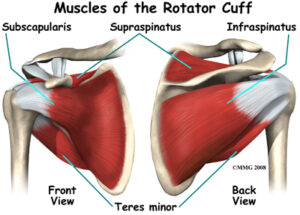Shoulder pain and rotator cuff injuries
The important stuff you need to know about rotator cuff injuries.

The rotator cuff is a very important group of four small muscles (supraspinatus, infraspinatus, subscapularis & teres minor) that connect the upper arm to the shoulder blade (see image). Their main role is to not only move and control movements of your shoulder but to also provide dynamic stability to the shoulder joint.
Unfortunately, rotator cuff tears, which can occur to any one of these muscles, are one of the most common causes of shoulder pain and disability in both the sporting and general populations and can make everyday tasks increasingly difficult and often very painful.
Research has shown that the risk of developing a rotator cuff tear increases with age. Jobs and sports that require repetitive overhead work also increase the risk of rotator cuff injury. Jobs such as construction, carpentry, electricians and painters as well as sports that require overhead movements such as swimming, baseball, cricket and volleyball can all predispose the shoulder to injury.
How do rotator cuff tears occur?
Rotator cuff tears generally develop as a result of either:
Traumatic events – Such as a fall onto an outstretched arm or lifting a heavy object
Non- traumatic events – Such as excessive repetitive use or normal age related wear and tear
How do I know if I have a rotator cuff tear?
Symptoms of a rotator cuff tear can vary from person to person, however, common findings include:
Pain on the side or back of the shoulder
- Pain in the upper arm.
Reduced shoulder movement and pain associated with overhead tasks such as changing a lightbulb or reaching for the top shelf of a kitchen cabinet or other tasks such as reaching behind your back or out to the side.
- A feeling of weakness with shoulder movements
Pain sleeping on the affected side
Should I get a scan?
Imaging studies, both Ultrasound and MRI, have shown that the prevalence of rotator cuff tears in asymptomatic (symptom free) individuals is approximately 50% in those aged between 40 to 60 years of age, and as high as 80% in those older than 80 years of age. (Harris et al, 2012). This means that if a tear is present on an ultrasound or MRI it may just be due to the natural ageing process and not related to your shoulder symptoms at all.
If you have shoulder pain and are unsure whether you require imaging, your physiotherapist will be able to determine if your pain is caused by the presence of a tear or any other underlying factors.
How can physiotherapy help?
Research has shown that physiotherapy management, specifically strength training, should by the first treatment option for rotator cuff injuries (Ladermann et al, 2015; Ainsworth et al, 2007; Collin et al, 2015).
Rotator cuff tears account for over 50% of all shoulder conditions seen by physiotherapists on a regular basis (Donatelli, 2011).
The first thing that we will determine is whether your symptoms are in fact due to a tear to the rotator cuff. This is achieved by a thorough assessment of your shoulder, neck and upper back including:
- A detailed history of your injury
- Clinical examination of your shoulder movements and strength
- Special orthopaedic shoulder tests
- Examination of your neck and upper back movements
- Palpation of your shoulder muscles and surrounding structures
- Determine if imaging is required
- Determine if you need to see an orthopaedic specialist
- Set specific, individualised rehabilitation goal
What does treatment entail?
A 1 hour initial consultation is recommended for your first session. After your assessment, treatment may include:
- Treatment and advice for pain reduction
Hands-on manual therapy for restoration of normal shoulder movement
- Restoration of normal neck and upper back movement
Specific strength exercises for the rotator cuff – see example here: https://www.clinicalphysio.com.au/post/rotator-cuff-strength-standing-shoulder-external-rotation
- Targeted speed and power exercises
- Incorporation of work/sport specific rehabilitative movements
If you think you may be suffering from a rotator cuff tear or have some shoulder pain and are unsure where to start, then get in touch!
